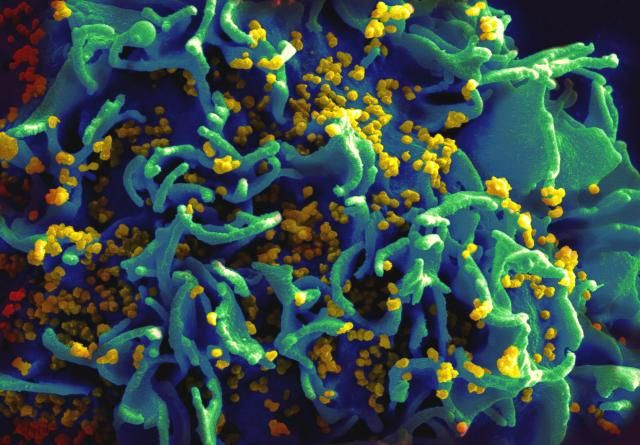HIV Prevention: NK Cells, Little-Known Immune Cells, May Be Linked To HIV Susceptibility

Diversity among Natural Killer (NK) cells in a person’s body may be associated with an increased likelihood of subsequent HIV infection, according to a new study. Researchers say their findings were unexpected, but that they may be useful in the development of blood tests that could determine a person’s susceptibility to HIV.
What Is A Natural Killer Cell?
A natural killer (NK) cell is a type of lymphocyte (white blood cell) whose function is critical to the immune system. They have the unique ability to recognize stressed cells in the absence of antibodies, which allows them to react remarkably quickly, regardless of whether the cells they’re attacking are virus-infected or tumor-producing. They earned their name by being the only immune cells capable of detecting and destroying pathogens that don’t contain the biomarkers normally identified by other immune cells.
These immune cells include T and B cells, both cousins to the NK cell. While NK cells innately respond to tumors and virally infected cells, T and B cells recognize specific “non-self” antigens on invaders. This allows them to generate a tailored immune response to the pathogen that was recognized.
The comparisons made between these two cells is critical to the new study, which shows how the diversity of these cells affects the body’s HIV susceptibility.
Cell Diversity — Both A Strength And Weakness
In the case of T and B cells, increased diversity was a positive thing, but the NK cells proved different. T cells have a number of receptors on their surface that recognize the protein snippets of other cells — this is what allows them to identify invading pathogens. The structure of these individual receptors varies from cell to cell, allowing the army of T cells to identify and sort hundreds of millions of potential invaders, hence their diversity.
NK cells, being the universal killers, don’t have these specialized receptors. Instead, they have various combinations of generic receptors, which tend to shift other cells into two categories: normal or “stressed.” If it identifies a cell as normal, the NK cell remains inhibited. If it identifies a stressed cell, which could be suffering anything from a viral infection to cancerous mutation, it becomes active.
That doesn’t mean NK cells can’t be diverse; they simply show it in a different way than T and B cells. Like T and B cells, diversity in terms of an NK cell refers to the combination of receptors on their surface. However, instead of having the ability to specify between different pathogens, all of these receptors have slightly different activation thresholds.
For the experiment, NK cells were exposed to HIV and the West Nile virus in a dish, and the scientists used a cutting-edge technology called mass cytometry to analyze each cell in a highly efficient and organized manner. They saw that exposure to the virus-infected cells increased the diversity of receptors on the NK cells, but also resulted in a diminished ability to replicate and kill.
"Our hypothesis was wrong," said Dr. Catherine Blish, assistant professor of infectious diseases and geographical medicine and the study's senior author, in a statement. "We didn't think NK-cell diversity would be a bad thing, or that NK cells' diversification would occur to the extent that it does with viral exposure."
The study also showed that while the diversity of NK cells differs from person to person, a single adult’s NK cell population remains quite stable, seeing little change over a few months. When it comes to newborns, however, an examination of umbilical cord NKs showed that newborns have very little NK diversity — most likely because NK cell diversification occurs over the course of a child’s life, as they’re exposed to more viruses, Blish said.
What’s The Link To HIV?
To test the effect of NK cell diversity on HIV susceptibility in humans, the researchers used blood samples that were drawn for a previous longitudinal study on pregnant Kenyan women. Some of the women had tested positive for HIV, and the researchers were able to use mass cytometry to analyze the NK cells in their blood. They observed a strong, positive correlation between the diversity of a woman’s NK cells and her likelihood of becoming infected with HIV. Even after controlling for age, marital status, knowledge of partner’s HIV status, and history of trading sex for money or goods, the correlation held.
Women with the highest levels of diversity in their NK cells were 10 times as likely to become infected with HIV as those with the lowest diversity.
Blish said that this information is far from negligible. "By way of comparison, having syphilis increases the risk of contracting HIV two- to four-fold, while circumcised men's HIV risk is reduced by a factor of 2.5 or 3," she said.
Though the findings are preliminary, they could be used to target those most in need of monitoring for viral infections. "This puts NK-cell diversity on the map as a metric of immune function," Blish said. "But it was a first foray. Before we can say definitively that NK-cell diversity predicts a person's susceptibility to infection, we need to validate these findings by looking at large numbers of individuals in a different population.
Source: Blish C, Strauss-Albee D, Fukuyama J, Liang E, Yao Y, Jarrell J, et al. Human NK Cell Repertoire Diversity Reflects Immune Experience And Correlates With Viral Susceptibility. Science Translational Medicine. 2015.



























